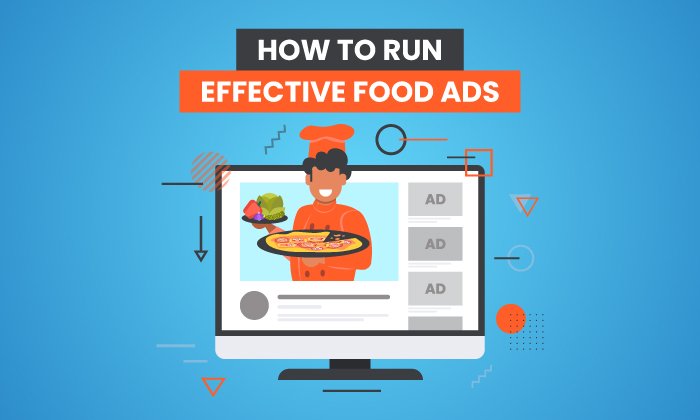The food and beverage industry is growing fast. In the foreseeable future, analysts predict this sector will increase by 4.74 percent annually.
It’s also an area where new trends are constantly emerging, giving food businesses more chances to get on board with “hot” products.
For instance, more recently, there’s been a high demand for health, immunity, and plant-based foods, along with flavors with global appeal.
Increasing growth is good news for food businesses. However, to gain traction, companies need to differentiate themselves.
One way to achieve this is through advertisements that hit the spot creatively.
Food brands often use creative ads that indulge the senses while appealing to consumers’ physiological and emotional sides.
How can you do the same? Here are some tips you can start using today.
8 Tips for Creating Effective Food Ads
Many of the best food ads use proven techniques to capture viewers’ attention, get people talking, and build customer trust. Regardless of your budget, these are all methods you can use in your food ad campaigns.
Let’s get started with the first one:
1. Use Visual Storytelling
Brands have used storytelling for decades. However, there’s now a greater emphasis on visual storytelling. Rather than relying on words, strong visual imaging enables food brands to gain viewers’ attention in a marketing world full of clutter and rivals’ messaging.
When a brand uses visual storytelling effectively, these food ads can encourage an audience to become regular customers.
However, what does visual storytelling mean?
You’ll find plenty of definitions online, but Shlomi Ron, CEO of the Visual Storytelling Institute, says it involves four main factors:
- creating compelling narratives
- ensuring the customer is the main focus of the story
- developing an emotional, visual media experience
- distributing these elements throughout the buyer’s journey
At a recent webinar, Ron explained how visual storytelling would shape the next decade, citing brands like Panera Bread.
The Missouri-based company used its drivers in a campaign to improve consumer trust and credibility among shoppers. However, if you watch most of Panera Bread’s ads, you’ll notice visual storytelling is part of them.
How can you do the same? By:
- Determining the reaction you want from consumers: Do you want them to feel happy? Relaxed? Confident? How can your ad convey that?
- Learning from the best: There’s plenty of good examples of visual storytelling around. Find a brand in your niche that does it well.
- Using tried and tested storytelling techniques: Hook your viewers from the first scene, show instead of telling, and create an effective narrative arc.
- Including customer stories: Make your ads customer-focused while addressing their concerns or wants.
Another way to do this is by demonstrating your values, showing your consumers what you care about, and how your brand makes the world a better place.
2. Choose Your Colors Carefully
Color is one of the most critical parts of your food ads. Picking the right color engages consumers and can affect their buying behaviors.
The right color also builds your food brand’s identity. In a sector where your branding needs to be bold to get noticed, it’s not surprising many food companies frequently use bright primary colors.
Food and drink brands often use reds, blues, oranges, and greens—and these colors all speak to shoppers differently.
For example, advertisers use red to trigger appetite, and consumers associate green with health. Yellow shades reportedly increase serotonin and happiness.
When choosing your colors, ask yourself what emotions are you trying to express? How does your typical consumer think when they buy your product? How does your chosen color fit in with your brand overall?
3. Show Your Brand’s Voice and Personality
There’s a wide variety of personalities in food ads. You’ll see everything from playful and fun to formal and even functional. It all comes down to the overall tone of the individual brand.
However, whichever voice you’re going with needs to be powerful, and your buyers must recognize and relate to it.
Once you’ve decided on your brand’s personality, it’s best practice to incorporate it across your business, including your:
- website
- packaging
- newsletters
- logos
Take time to decide on your brand’s voice and ensure it’s consistent. Do you need inspiration? Take a look at Starbucks.
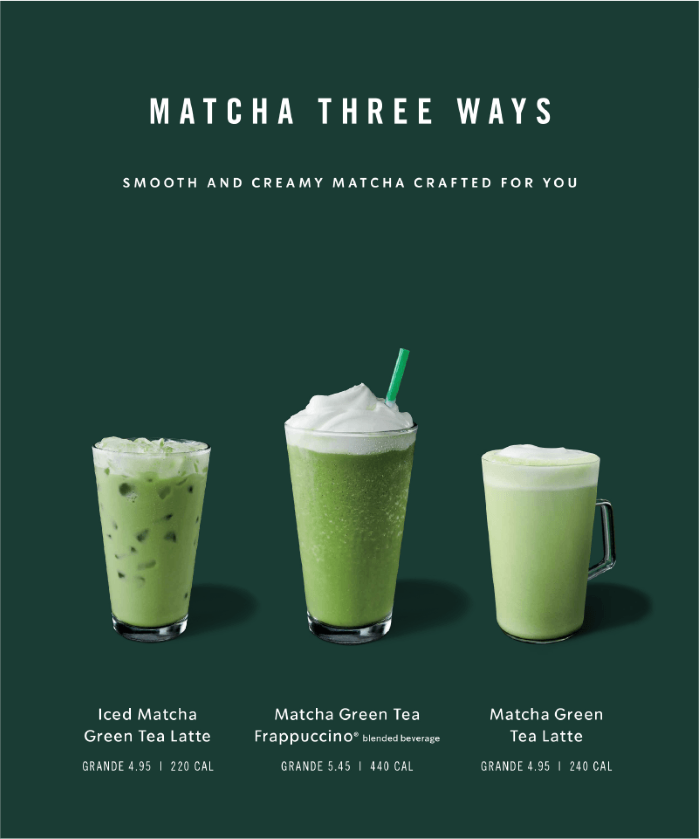
As the company explains, it’s gone with an expressive, functional voice, and it uses the same tone in-store, on social media, and its website. Starbucks incorporates the same styles of typography throughout too.
Take a note from Starbucks and create consistency throughout your food ads, right from the colors you use to the typography and tone.
4. Research Each Platform for Advertising
You could create the world’s best food ad, but if you’re putting it in front of the wrong audience, it’s going to be a waste of time and money.
There are many ways to get your brand noticed, but don’t feel like you have to be on every platform. The right vertical for you depends on who your market is and where you can find them.
If you’re using social media, then according to Up Menu:
- Facebook has enormous potential for restaurants.
- Twitter works best for sharing details of food industry happenings.
- Instagram and Pinterest work well for visual storytelling and sharing images.
- YouTube is the most obvious choice for sharing video guides.
Additionally, many food brands are using TikTok well, like Chipotle and Kool-Aid.
It’s not all about social media, though. A lot of us consume information in different ways. Some prefer the website or blog format, while others like information presented in a newsletter or video adverts to watch on the go.
Make sure you understand your audience’s preferences so you can reach them and think of creative ways to captivate them.
5. Engage With Your Audience
While it won’t always be applicable, engaging with your audience is essential for brand building, and there are many ways you can do this.
Social media is open to everyone. It’s also one of the easier ways to engross your audience. You could do this by:
- sharing your food ads and inviting views
- asking followers to create user-generated content
- offering discounts and contests.
Away from social media, you could include calls to action (CTAs), website links, and sign-up forms to drive customers back to your site and nurture leads.
6. Keep Ahead of Trends
Knowing what’s hot is an effective way to boost your sales. One of the quickest ways of keeping up with new fashions is Google Trends.
You can use Google Trends for global searches or more localized regions, making it ideal for picking up on niche ideas for a specific area.
For instance, if you search for “food,” then “take out food” and “fast food restaurant near me” appear in the top five.
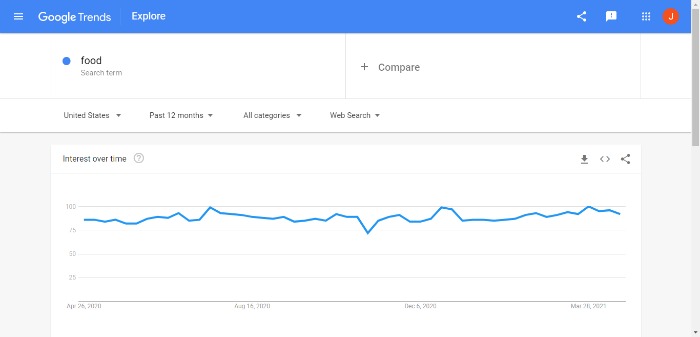
Niche it down further to “ice cream,” and you’ll get more specific search terms you could potentially work with.
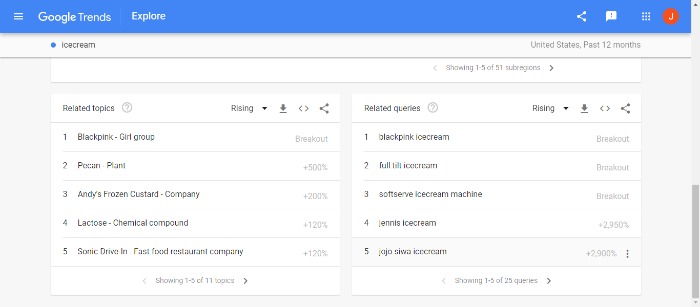
Other ways of identifying trends include Ubersuggest. There’s a free tool available, or you can sign up for the paid version for more features and a seven-day trial.
7. Make It Personal
Put a face to the name or tell the story behind the brand’s origins in your advertising. Amy’s Kitchen, for example, does this well.
You’ve only got to look at the story on the packaging to know Amy’s Kitchen is a family business that advocates organic, wholesome foods. If you go further and look at the website, you’ll see a group of happy employees. Additionally, you’ll learn that Amy’s supports local farmers and cares about quality.
As you can see, Amy’s advertising reflects their wholesome branding.
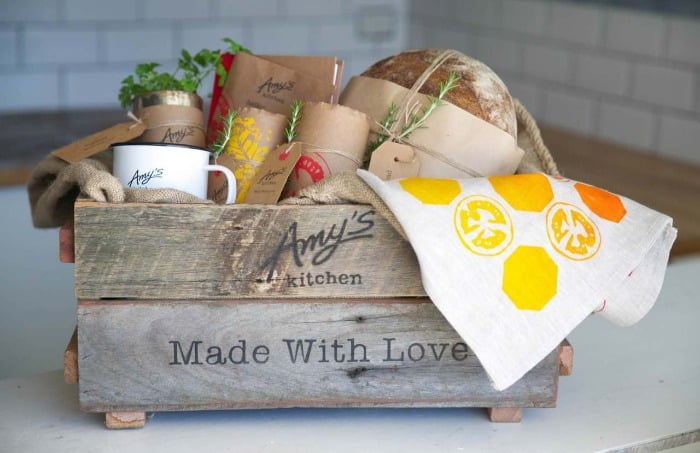
Amy’s Kitchen also supports its message about eating well and community through:
- newsletters and blog posts
- explaining its philosophy
- giving visitors a glimpse inside its business
These are all things your brand can learn from and incorporate into your food ads. What’s your unique story, and how can you use it in your branding? Can you:
- Tell the story of its origins?
- Feature your images?
- Include your name in the brand?
- Explain your company ethics?
Anything that differentiates your food ads will give you a better chance of getting noticed and set you apart from competitors.
8. Tell Your Customers What to Do Next
Your customers or potential buyers have finished reading your emails, looking at your newsletters, or visiting your social media pages.
What do you want them to do next, and how do you express this?
The usual technique is the CTA. For instance, if a would-be customer visits your website, where do you want them to go from there?
Do you want to encourage them to sign up for a newsletter or social media so they can learn more about your brand? Tell them, and maybe even offer an incentive!
3 Examples of Effective Food Ads
The advertising world’s given us many memorable moments. Whether it’s taking center stage at the Super Bowl, or just one of those great food ads you’ve seen on the TV that’s got you talking, these adverts are part of our culture.
Here are some of the best examples:
Chipotle
Chipotle is a real success story. It’s innovative, accessible, and excelling in its digital sales. However, that’s not the only area where the California-based Mexican grill shines.
Chipotle is great at making adverts that get noticed. Let’s take its “Back to the Start” campaign as an example.
The animated ad debuted in U.S. movie theatres and at the Grammys. It’s a great example of visual storytelling. The ad highlights why we should consider looking towards a more sustainable approach to farming and food.

What makes the ad so great is it not only used visual storytelling to its maximum but also touched on a subject people care about, demonstrating an understanding of its audience and beyond.
Further, it showed the brand’s personality, and Chipotle put plenty of consideration into its chosen platform.
Anyone can take the Chipotle approach in their food ads: use visual storytelling, engage an audience, and create a compelling narrative. Then ensure you put the ad on the right channels to get it noticed.
Taco Bell
Taco Bell has got social media advertising down to a fine art. When it’s not promoting its latest products to its near one million Facebook followers, it’s taking the educational approach.
Taco Bell uses its ads on Facebook to create a sense of urgency or excitement by announcing the return of old favorites or new store openings.
Then there’s the educational side. On Taco Bell’s Facebook page, you’ll see a series of videos that give viewers a glimpse behind the scenes.
Further, Taco Bell increases engagement by giving a sneak peek at new locations or its Bell Hotel. It then enhances trust by explaining how they serve customers safely and promotes timely, seasonal offers to drive sales.
Finally, Taco Bell uses personalization, trends, and exclusivity in its advertising, as you’ll see below.
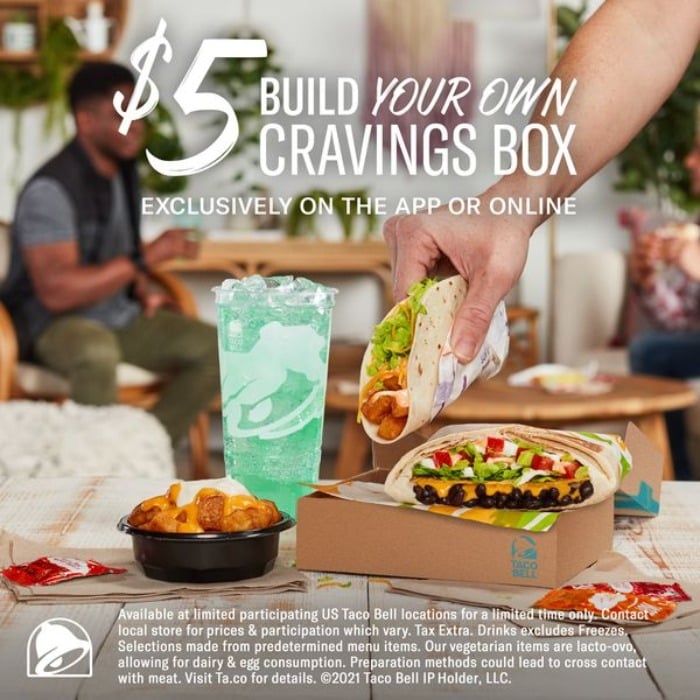
Taco Bell’s “Build Your Own Cravings Box” works on multiple levels:
- It appeals to people’s desire to personalize while highlighting affordability and limited availability.
- It also adds exclusivity by limiting its offer to online and app users, capturing the audience where they are at the time.
- With the imaging, you’ll see mouth-watering food and a leisurely image, cementing Taco Bell’s reputation as friendly and family-orientated.
In other words, Taco Bell says a lot without using complicated imagery or too much detail. This shows that sometimes the simplest ideas are best.
M&M’S
Another way to engage an audience is to make your food ads fun, and this is something M&M’S achieves with ease.
M&M’S ads have been making us laugh for years, and some would say the brand exceeded expectations with one of its Super Bowl ads.
Taking its inspiration from modern life, the ad included everything from a “Karen” and “Mansplaining.” Dan Levy of “Schitt’s Creek” fame also put in an appearance.
Above all, though, the ad sought to make us feel more connected. Sarah Levy, Chief Marketing Officer at Mars Wrigley North America, explained the ad’s purpose was to: “Create better moments that make the world smile.”
If it’s in keeping with your brand, ask yourself how you can do the same.
Conclusion
The food industry is one of the most competitive, but that doesn’t mean your brand hasn’t got what it takes to get noticed.
There are several ways you can make your food ads more appealing to consumers, and it doesn’t need to cost you a lot of money.
Creating a consistent style and tone, adding some personality, and engaging with your audience is something every food business can do. You can also take inspiration from famous names like Chipotle and Taco Bell by using visual storytelling or an educational approach to keep your audience interested.
Whichever method you use, make sure you choose the right platform so you can reach and engage with your ideal audience.
Which food ad stands out for you? What are your best tips for creating effective food ads?

